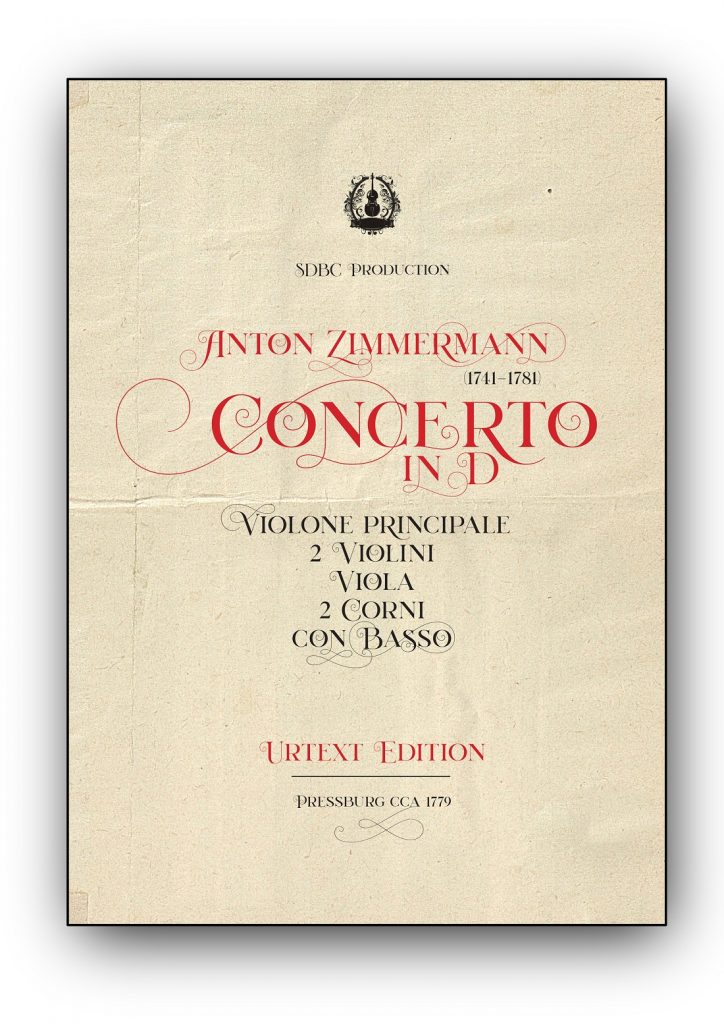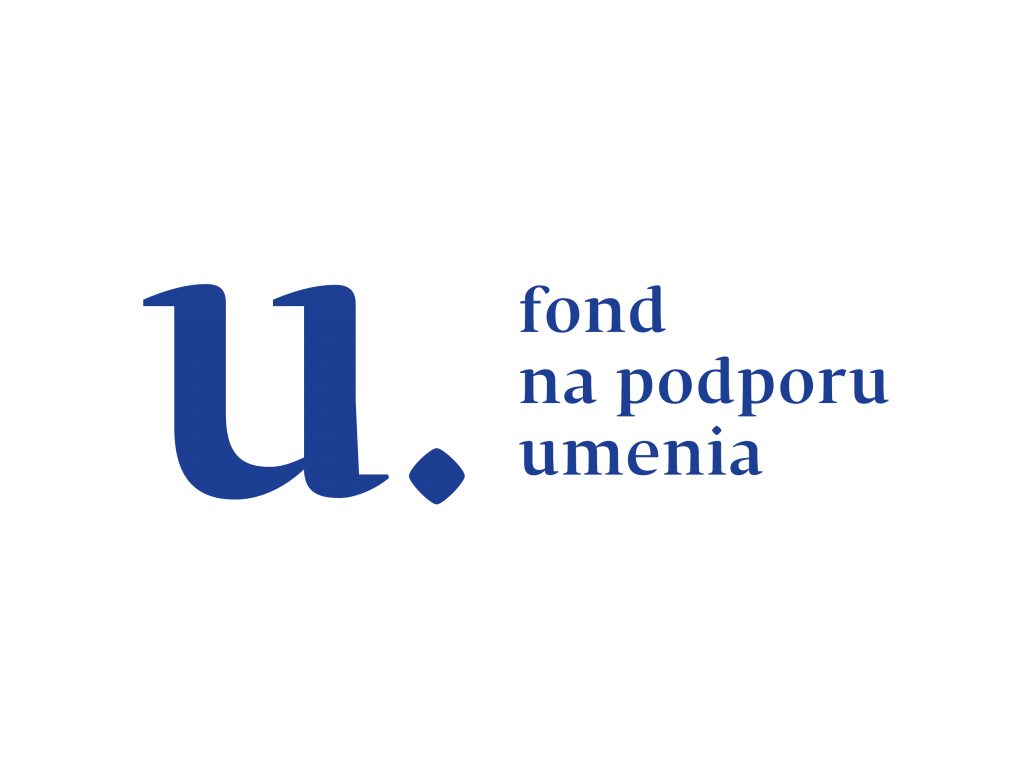We would like to present to you a newly published publication/critical edition – sheet music with complete parts of Anton Zimmermann’s work – Concerto per il Violone in D.
You can read all the important information about the work and the critical edition in the text below. In this context, we allow ourselves to express immense joy and pride regarding the release of this concert, as it is being released in the world premiere and you can order it in our e-shop. (Also available on CD – Contrabasso/ Violone in Presbourg)
Ján Prievozník/ SDBC.
 Ján Anton Zimmermann (1741 Breitenau – Široká Niva in the Czech Republic – 1781 Bratislava – Presbourg)
Ján Anton Zimmermann (1741 Breitenau – Široká Niva in the Czech Republic – 1781 Bratislava – Presbourg)
His work should be seen not only in the context of his place of work in Bratislava, but also in the broader context of the musical history of the period of classicism in the intentions of contemporary Hungary, where he is one of the most representative exponents. He worked as an organist in Königgrätz (today Hradec Králové), in Opava, Brno and Olomouc. In the early 1970s, he came to Preßburg. In the following years, he worked primarily as an organist and composer. It wasn’t until 1776 that he got the position of court bandleader, violinist, artistic director, and later (1780) also the position of organist in St. Martin. Zimmermann’s Dome, although he was not a native Slovak composer, he is still considered a local composer. He worked in today’s Bratislava almost his entire life and left a legacy there in the form of the works of most of his creative compositional activity until his untimely death (he died at the age of 40).
Anton Zimmermann was a very productive composer and his works were often confused or attributed to his contemporaries such as Sammartini, Albrechtsberger, Holzbauer and also K. Ditters von Dittersdorf, and even W. A. Mozart or Michael and Joseph Haydn.
His musical legacy consists of 276 works (40 symphonies, 4 concertos, 49 chamber pieces, 8 divertimentos, 7 masses, litanies, 2 melodramas and song plays, cantatas, quartets and other smaller pieces). If we take into account the fact that he composed this work during his 10 years of work in Bratislava, then in addition to his activities as a concert artist, band artistic director and later cathedral organist, he is really a very productive author.
Last but not least, Zimmermann should be mentioned as a great bandleader and violinist. His work as the artistic director of Count Batthyány’s band in Preßburg in the years 1776-1781 is evidenced by several contemporary documents, including the frequently-cited Preßburger Zeitung source. (Preßburger Zeitung, No. 94, November 24, 1773)
Double bass concerts:
As it is known today, Anton Zimmermann contributed to the development of double bass literature with two double bass concerts. The concerto known and played today comes from the archives of the Landesbibliothek Schwerin (Mus 5187) and was found here in the transcription by J.M. Sperger. It was J. M. Sperger who worked under the baton of A. Zimmermann in Count Batthyány’s band in today’s Bratislava. However, since we know that A. Zimmermann also composed another concerto (the second or more precisely the first in the sequence), we are prompted for a certain hypothesis and polemic about determining the origin and historical context of the creation of this work.
Zimmermann: Concerto per il Violone in D.
The work you are holding in your hands is created on impulse, or it is dedicated to the senior double bass player, viola da gamba, cello and violone player Joseph Kämpfer. Kämpfer was born in Bratislava in 1735 and was a member of the Batthyan band. It is possible and, according to the available research, it is also obvious that next to the very active Sperger, Kämpfer remains slightly in the background
(he is also referred to as a cello player). However, according to the manuscript of the concert published here, it is certain that it belonged to and was premiered by Kämpfer, probably on November 19, 1779 in Bratislava. From biographical, temporal, technical and artistic aspects, it is almost certain that this work was created earlier than the now well-known concerto for double bass and orchestra in D. Based on research and artistic and historical deduction, we can classify this concerto as
A. Zimmermann’s 1st concerto.
Concerto in D Violone Principale, Violini 2, Viola obl, Corni 2, Con Basso, Del sign Zimmermann, (Kämpfer).
From an artistic point of view, the concert bears all the important features of
a work of high classicism. The compositional style and all its elements, such as figurations, harmonic and melodic procedures, are very mature and testify to the high level of experience of Zimmermann as a composer. It is also necessary to notice the author’s different approach when composing both of his double bass concertos. While the concert preserved in the estate of J. M. Sperger was composed “into the hand” of Sperger, so to speak, and he places his musical-expressive, technical and interpretive demands on the limit of the range of the instrument, the concert published here bears all the marks and attributes of gamba technique while respecting expressive and technically interpretive possibilities and means. It goes without saying that, like other literature of this period, this concert was created for the so-called Viennese tuning, that is, third-fourth tuning.
We are honored as Slovak Double Bass Club publisher, that we managed to publish this valuable work in its critical edition while respecting all the original aspects found in the period score. Original registration or more precisely a contemporary copy was preserved in Kremsmünster Abbey (Benedictine Monastery), from where this source of the edition of Zimmermann’s Violin Concerto also comes.
We believe that in times when playing the so-called double bass Viennese tuning is in the wider interest and attention of double bass players worldwide, this work will get into the hands of capable performers, researchers and enthusiasts of solo double bass playing, and A. Zimmermann’s music will enrich the double bass repertoire on a global scale.
Ján Prievozník, author of the text and edition
Critical edition of the work:
Various errors are found in the parts themselves obtained from the museum in Kremsmünster. These errors occur due to carelessness in transcripting of the work, or the composer’s own error or imperfection, which is difficult to read in the part, etc. With articulations written in the score or original parts, it often happens that this is not understood correctly, or badly written or written with only a hint. If we look at the original part through the eyes of the performer, we will find out where and what articulation possibilities are permissible, appropriate, and where, on the contrary, the present legato, ligature or other articulation is a departure from the customs of the time and the articulation possibilities of the given instrument. In the case of the double bass solo voice, the articulation is often only indicated, the legatos above the notes are not continuous, or are incomplete or otherwise unclear. On the contrary, there are places where the articulation is clearly indicated, and therefore even parallel places and their articulation can be transferred or copied to the given place.
It is the same with incorrect notes, of which there are unfortunately several in this piece as well. They are of course the subject of a critical report. When repairing them, we were based on harmonic principles, consonances or compositional practices and principles (avoidance of parallelisms, doubled tones, etc.). In places where sheet music is missing or incorrect or incomplete, we tried to supplement or correct it in the most effective and time-correct way possible.
Dynamics: a contemporary practice that we encounter quite often is that it was often only hinted at. The author assumed that respecting her was dependent on other voices. It also happens that in the work there is a different dynamic sign in one voice than in the other voice. We united these places in the most logical way, but again with the principle of comparing identical places in other voices, etc.
As happens with many works found after many years, this work also suffered from the loss of the original part, in our case the part of the 1st horn (1. Corno in D). Therefore, we had to resort to adding it. Fortunately, thanks to the 2nd voice of the French horn, it was possible to compose this lost part, again respecting the principles of classical compositions and compositional rules.
Z verejných zdrojov podporil Fond na podporu umenia
Supported using public funding by Slovak Arts Council

 Slovenčina
Slovenčina